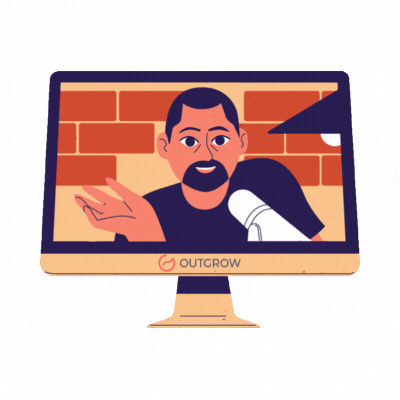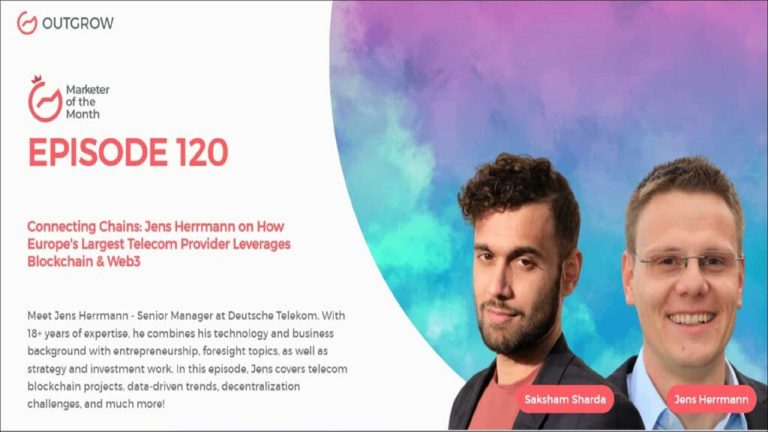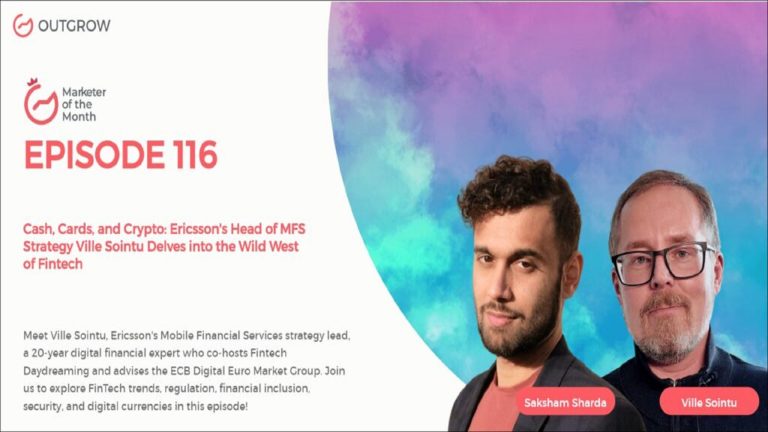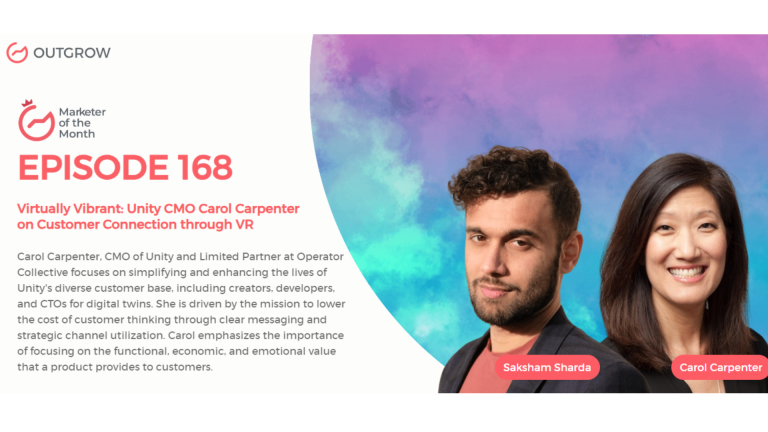
We recently interviewed Jay Baer for our monthly podcast – ‘Marketer of the Month’! We had some amazing insightful conversations with Jay and here’s what we discussed about –
1. Studying the audience correctly
2. Influencer marketing and the correct platform
3. Becoming a bridge for our client’s client
4. How can you make the customer journey effortless?
5. Influencer marketing platforms that work well
6. Right modality and the message triangle
7. Advice for podcast hosts
8. Radical Relevancy
9. Using highly relevant content
Oh! And we learnt a new term – Radical Relevancy! Any idea what that means? Never mind! Just start reading and you’ll know!
About our host:
Dr. Saksham Sharda is the Chief Information Officer at Outgrow.co He specializes in data collection, analysis, filtering, and transfer by the means of widgets and applets. Interactive, cultural, and trending widgets designed by him have been featured on TrendHunter, Alibaba, ProductHunt, New York Marketing Association, FactoryBerlin, Digimarcon Silicon Valley, and at The European Affiliate Summit.
About our guest:
Jay Baer is a 7th-generation entrepreneur, author of 6 best-selling business books including Youtility- Why Smart Marketing is About Help Not Hype, and founder of 5 multi-million dollar companies, tune in to listen to Jay, founder of Convince & Convert Consulting, a digital marketing and customer experience advisory firm that helps the world’s most iconic brands gain and keep more customers.
The Podcast – Youtility and Radical Relevancy with Jay Baer
Table of Contents
The Intro!

Saksham Sharda: Hi, everyone. Welcome to outgrows marketer of the month. I’m your host, Dr. Saksham Sharda. I’m the creative director at outgrow.co. And for this month, we’re going to interview Jay Baer, who is the founder of Convince and Convert and author of six books on marketing and customer experience.
Thanks for joining us, Jay.
Jay Baer: Delighted to be here. Thanks for having me.
The Rapid Fire Round!

Saksham Sharda: So we are going to start with a rapid fire round just to break the ice. You get three passes in case you don’t want to answer the question, you can just say all right, good. But try to keep your answers to one word or one sentence only.
Jay Baer: Okay. Yes. All right.
Saksham Sharda: So the first one, how long does it take you to get ready in the morning?
Jay Baer: 15 minutes.
Saksham Sharda: Okay. Most embarrassing moment of your life?
Jay Baer: Most embarrassing moment of my life. That’s a tough question. So when I was in high school, I accidentally pulled my friend’s boat out of the water without a trailer and ruined his boat and left like a 200 yard fiberglass on the concrete. So that was not great.
Saksham Sharda: Okay. How many hours of sleep can you survive on?
Jay Baer: Seven probably.
Saksham Sharda: Fill in the black. An upcoming marketing trend is_________.
Jay Baer: User generated content.
Saksham Sharda: All right. The city in which the best kiss of your life happened?
Jay Baer: Tucson.
Saksham Sharda: Pick one, Mark Zuckerberg or Jack Dorsey?
Jay Baer: Is there an option C? Is there a third category? I’ll go with Dorsey. Just cause he’s weird.
Saksham Sharda: The first movie that comes to your mind when I say the word Ambition.
Jay Baer: Yeah. Interesting question! The Martian.
Saksham Sharda: When did you last cry and why?
Jay Baer: Last week we had to put our dog down.
Saksham Sharda: Oh, okay. The biggest mistake of your career?
Jay Baer: I would say a green to quick-fire rounds! But, the biggest mistake in my career was not starting my first company sooner.
Saksham Sharda: Okay. How do you relax?
Jay Baer: The real answer is Tequila, for purposes of the podcast, I’ll say I like to go for long walks and listen to audio books.
Saksham Sharda: How many cups of coffee do you drink per day?
Jay Baer: Two. Okay.
Saksham Sharda: A habit of yours that you hate?
Jay Baer: Well, I wish I didn’t have to drink two cups of coffee every day.
Saksham Sharda: Okay. The most valuable skill you’ve learnt in life?
Jay Baer: Flexibility.
Saksham Sharda: Your favorite Netflix show?
Jay Baer: Oh, that’s a tough one! Right now, I am watching Fauda, which is an interesting three season show about the Palestinian Israeli conflict, and like kind of special forces and all that. It’s good!
Saksham Sharda: Okay. Alright so that was the end of the rapid fire round.
It did take a little too long to answer one question. So I’m going to give you a nine on 10 in a car.
Okay. So let’s go into the bigger questions now.
The Big Questions!

Saksham Sharda: Name me one unique way in which you help your clients with convince and convert.com?
Jay Baer: Well, I think partially it’s that we offer kind of a narrow set of services. Convinced & Convert is really a strategy consultancy. We help major clients think through content strategy, social strategy, customer experience, strategy. But we don’t then typically execute on those programs. And so it really is unusual in that we get asked all the time, like, thanks for the strategy. Could you also put this into practice? Like, no, we don’t do that. We only do strategy and it’s been that way since the very beginning. It’s definitely a differentiator. And it allows us to have a laser focus on kind of business outcomes and not get caught up in well, can we do this particular tactic 5% better?
Saksham Sharda: Hmm. So you have worked with around 700 companies, which includes 36 of the fortune 500?
Jay Baer: Yeah, it’s more than that!
Saksham Sharda: Oh, I guess it’s increased since we last got these numbers, but yeah can you share an impactful experience that changed your life in any possible way while working with these companies?
Jay Baer: Oh, I mean, I’m really fortunate in that. I have experiences like that all the time. It’s you know.. when you’re involved in some interesting projects around the world, I guess the one that is really most recently relevant is we did a huge project with the university of Arizona, which coincidentally where I went to school, and helped them launch and distribute the COVID watch app, which was a Covid 19 notification application using anonymous Bluetooth signals. And we were able to generate some 25,000 downloads of that application in the first two weeks that it was available, which is huge and definitely helped protect the campus community and keep COVID at bay there and you know, that was certainly one to remember.
And I would also say we’ve had the good fortune to work with the United Nations over time, especially the food and agriculture organization. Which is, you know, their mission statement is to eradicate world hunger, which is a fairly big stake. And we built out a whole global social media strategy with them a few years ago, which is really gratifying.
Saksham Sharda: Hmm. And, what is one impactful way in which this has changed your life for the better or worse?
Jay Baer: For me, it’s understanding that even though there’s not very often there’s a marketing emergency or a content emergency, social media and the work that I do and my team does has value. Right! It can actually, I don’t want to say quote, unquote, change the world because I feel like that’s kind of a pat phrase, but that this work can matter.
And I think sometimes marketers can fall into the trap of, you know, why am I doing this? You know, I could be, I could have been a doctor and instead I’m in marketing and maybe I’m using my powers for evil instead of good. So, it absolutely made those kinds of projects make me feel better about the career that I’ve chosen.
Saksham Sharda: And what is the one thing you hope for your company to achieve?
Jay Baer: I think more than anything else it’s we want to make sure that our clients can leave the world a better place. By being more effective business people through our council. You know, we often spend time thinking about, you know, what does the client of our client want and how can we be a bridge to that?And, that can sometimes be a diffuse concept, but I think it’s really important to keep in mind.
Saksham Sharda: And when it comes to something like influencer marketing, which platform do you think works well?
Jay Baer: They all can work. Well, I don’t think there’s any that are inherently better. I mean, there’s lots of effective influencer work on LinkedIn and certainly snap and Insta and Facebook, and Twitter, and TikTok.
You know, it depends on the audience and who you’re trying to influence. So I would argue that the algorithm on TikTok is such that you can create spikes of influence faster there than anywhere else at this point. But you know, a lot of our clients are large B2B organizations. Oracle, for example, we do a lot of influencer marketing for Oracle.
They’re not going to run a TikTok influencer campaign. It’s just not really an Oracle thing. And so for groups like that it’s how do we unlock influence on LinkedIn or Twitter or even YouTube or blogs, etc. So I don’t have a preferred platform and we tend to pick whichever one makes the most sense for them.
Saksham Sharda: And, do you know of any B2B company that’s had any kind of success on TikTok?
Jay Baer: Oh, absolutely. There’s lots of them. It’s just not necessarily through influencer marketing, per se. I’m seeing lots of B2B organizations are starting to use TikTok, for recruiting, and Cisco is one of them; one of our clients, and they’re active on Tik TOK and it’s really to become an employer of choice.
It’s such a battle for talent right now. Especially on the technology side and if you can become the fun hip cool company, maybe you’re going to get some extra applications and that can pay off in the long run.
Saksham Sharda: And why recruiting specifically on TikTok?
Jay Baer: Well, the thought is that if you’re going to try and recruit, in many cases you’re looking for young professionals or early career professionals, because if you get into the company early, maybe end up making a career of it, right. Maybe you ended up staying there for 20 years or 30 years. What have you? So if you can get young talent, usually that’s more cost-effective long term for the company than acquiring mid career, late career talent.
And just because demographically TikTok skews younger, that’s where many of those young professionals are gonna be hanging out.
Saksham Sharda: Interesting. And what’s your go-to strategy when it comes to content marketing today?
Jay Baer: Radical relevancy is really what we try to achieve. You know, time is the only inelastic resource, right? Everybody has the same amount of time. And as soon as you start to waste your audience’s time by putting content in front of them, that is not highly relevant, that’s where your audience starts to get really unhappy.
And they start to tune you out and I would argue probably rightfully so. So we really want to make sure that wherever possible we’re using the right messages and the right messenger, which is why I’m a big proponent of user-generated content and the right modality.
So some people really prefer videos, some people prefer podcasts and people prefer reading. And so we try to make sure that as much as possible, we know which of that right message, messenger and modality triangle, make sense for our particular audience and we doubled down on that.
Saksham Sharda: Hmm. And speaking of which, what are the key moments in the customer journey that should be avoided to make the journey smoother without any leakage?
Jay Baer: It depends on the business. You know, your journeys are going to vary by industry and by company. But typically the journey stages that are less effective and most organizations are ironically the lower funnel stages. We put a lot of time, money and effort into, into high funnel, communications and content and let’s attract new customers and get them excited and branding and introduce people to our organization and blah, blah, blah, blah, blah.
And I’m not saying that’s not important. It is! But it is very disproportionately resourced in most organizations and there’s very little content or attention paid to; Hey, how do people make that last mile decision when they’re comparing you versus another company? And they’re saying, all right, who’s going to be cheaper or total cost of ownership, or I’ve got some specific questions before I make a purchase.
Usually that kind of very specific late in the consideration funnel touch point is not fleshed out very well. And that needs to get fixed. And so we spend a lot of time helping our clients think through things like, how do we make sure that we don’t just answer questions that people have early in the process? But that we can effectively answer questions that they have all the way through the process.
Saksham Sharda: Could you give us an example of a company with which you’ve managed to actually shorten this process a lot?
Jay Baer: Let me think about that! Yeah, so for example, one of our clients is California tourism. We do a lot of work with ‘Visit California’, which is the tourism authority for the state and have done a lot of customer journey mapping with them.
And one of the things that we worked on and changed over the last year, is how people can navigate through the website where previously you had to kind of go through, sort of a chutes and ladders approach to go to a section and then a subsection, a sub-subsection to sort of get to some very detailed information about your potential trip.
Based on the research we did in customer interviews and journey mapping, we kind of re-architected the way the site works so that if you were pretty well… You know you’re going to California, you know you’re going to Southern California, you know you’re going to Venice; if you already have that information in your head, you can more quickly get the details and sort of skip through step 1, 2, 3, and four.
And we’ve seen really positive outcomes from site visitors and actual visitors to the state of the result.
Saksham Sharda: And have you employed things like quizzes or something to help people; to funnel people through these different avenues?
Jay Baer: Yeah, absolutely and also just how you make content available at each page right!
Do you have to click into a menu to get into a sub menu, get into some set menu or do you give them, do you sort of take some of those sub sub options and bring them up a couple of levels so that they’re gettable earlier.
Saksham Sharda: Fair. And what does the team behind jaybaer.com look like? Like when you get this company, like California tourism, how do you guys approach? You know, within your organization having a targeted approach towards this company?
Jay Baer: Yeah. So, we have, 1, 2, 3, 4, 5, 6, 7 strategists on the team, who spend their time doing content strategy and social strategy and CX strategy and digital strategy. And then we have a content creation arm as well, which includes some content directors and a couple of writers and some strategists and some account managers, and myself and some business development people, but there’s only 15 of us.
And that’s kinda how I like it. I never wanted to build a really large organization cause I find that you just get bogged down in running the company and not doing great work. And so every time we have a client like ‘Visit California’, we have a lead strategist, who really works on the project. They usually have a partner on the team who is kind of their backup dancer.
And then I get involved strategically on major projects and kind of jump in and say, Hey, have you thought about this? But I’m really fortunate in that. I am not working day to day, minute to minute with all the clients, which allows me to spend time doing what I primarily do, which is podcasts and giving speeches and writing.
Saksham Sharda: Okay. But then you’re not getting involved with every single one of your clients, even though there’s a 15 member team. So not all the entire team is not getting involved with one client?
Jay Baer: No, usually it’s on any particular client typically four people max would work on that client. And realistically it’s more like two people.
Saksham Sharda: Okay. And since you have a podcast, do you have any advice about podcasts that you’d like to give to our audience, who’s also some of them are podcast hosts?
Jay Baer: Yeah. I’ve been doing this for a long time. My main show is Social Pros, which is a podcast for people who run social media for major brands.We’ve been doing a weekly show since January of 2012.
So we’re almost at 500 episodes. It’s a top 15 marketing podcast ever. According to Apple, millions and millions and millions of downloads. I think part of it is, and we have also produced at least a dozen shows for clients. And I like the way you’ve structured this program, especially with the lightning round.
At the beginning, you have to have a consistent show format and you have to be very clear on who the show is for. I’ll tell you this. I’ll give you a little, a little rant here for a second. The problem with most content and the reason why most content doesn’t succeed at the level that you want it to is not because it’s too specific.
It’s because it’s too broad. The only way you can have a successful podcast, truly successful, is if your show is somebody’s favorite podcast in the whole world. It has to resonate with some group of people so much that they’re like, I’ll drop every show before I drop this show. And the only way you can make that happen, the only way you can build that kind of bond with an audience is if you’re really specific, right?
If you’re like, yep, this is the show for people who are left-handed vampires, that’s the show for them. And most podcast hosts, especially now, are trying to cast a very wide net. And they’re trying to say, well, you know, who’s your target audience? Well, it’s business people 25 to 54. I’m like, good luck! That show will fail!
I can tell you right now. So it’s something you really have to understand. I talked to you earlier about radical relevancy in podcasts. It’s the same way you really got to keep in your head all the time, Who am I talking to exactly? And make sure that you create a show for them.
Saksham Sharda: Hmm. How, and when did you come up with the phrase radical relevancy or did you borrow it from someone?
Jay Baer: No, I always come up with all my own stuff. I don’t even know. It’s probably been like three years. I think I first coined that phrase when I was working on a speech for the Content Marketing World. And I always write a new one every year, I speak there and I always write a new keynote for that event.
And I sort of use some of those raw materials in the future. Kind of treat it as like a test audience. And I think I started there.
Saksham Sharda: Speaking of which, what is a good way for anyone who’s listening, to get on a conference as a speaker, if they’re like, you know, influencers are listening and they want to speak at Content Marketing World? How did you get around to doing that when you were just starting off?
Jay Baer: Well, I’ll tell you how it actually started. First I started a blog. So the Convince and Convert blog, which at one point was only written by me, got pretty popular and now we have thousands and thousands of blog posts and millions and millions of readers every year. But, for a while it was just me and I was writing five blog posts a week by myself every week for like two years, three years.
And the blog got popular. Then a book publisher asked me, Hey, do you want to write a book? I said, yeah, I do! And I did at that point with my co-author, Amber Naslund. When we launched, the book called the now revolution in 2011, I believe, we did a book tour and we did like a 20 or 30 city book tour in each city.
We gave a speech, and talked about the book and signed books and people were like, well, that was a really good speech! You should do that more! And I said, should I? They said, yeah, you should!
So then we started to do more and more speaking and people asked me to give presentations, for free and I just did more and more then started to realize the key is to not give the speech that you want to give, but to give the speech your audience needs to hear.
And what I mean by that is if you want to go speak at any particular organization or association or conference or company or whatever, you have to really study and say, all right, who has spoken to this audience before? What have they been told? What is true for this particular audience today or this company today, what has changed in their life in the last year?
So one of the things that I do and now I do a hundred speeches a year, is I do a ton of research! Like I spend hours and hours for every presentation, customizing the presentation to the needs and realities of that audience. For me, yeah, it’s a speech and I’m holding a microphone, but it’s really consulting, you know, on zoom or consulting in a ballroom.
And that’s how I treat it. Right. So I tell people in an audience a lot of the same things I would tell them if they were a consulting client, I just do it in a more entertaining way, that’s more of a show.
But what I think is a bad approach, is to say, I’ve written this talk about whatever I’m passionate about. Who can I give this talk to?
Instead, I would say, Who’s the audience? And how do you write a talk that they’re gonna love.
Saksham Sharda: True Marketo! But, I was going to say, do you do the research yourself, or do you have a team that helps you out for the research?
Jay Baer: As it turns out, when I first started as a speaker, I did have an assistant helping me, but I realized that it’s actually faster to do it myself.
Because I can store it in my head as I’m doing the research. And so it’s like, okay, learn a thing, figure out how to incorporate it, build it into the deck. But before, when somebody was giving me, here’s some notes that they found, then I’d have follow-up questions. And if we go back to them, it just ended up being faster to do it myself. So, that’s how I do it.
Saksham Sharda: So, yeah I kind of get your philosophy that like, you know, you need a 15 person team and you like to like, you know, cause that’s some would argue a small team, but you’re able to do so much with 15 people in the same way as you’re able to do so much by yourself!
So are you very controlling in that sense when it comes to projects?
Jay Baer: I’m controlling about projects that I am going to personally deliver, especially as a speaker, right? Because all you have is, you know, how good was your last speech? And that’s why, like, if I do virtual presentations and of course I did lots of them during COVID, I don’t ever let anybody else design my slides or create a deck and say, Hey, let me have somebody on the team, make a deck and then give it to me and I’ll present it.
Like never. I just won’t do that. I can’t do that, but on the strategy side, absolutely for me, the best case scenario is the client never talks to me and doesn’t care! Because the people that I have on the strategy team are so good. And they’re just as good, if not better than I am, that it doesn’t matter if I am working on the project or talking to the client, it’s not relevant.
Saksham Sharda: Fair. Okay. So the last question for this interview is, what would you be doing if not this, if not what you’re doing in the world right now?
Jay Baer: If I could choose, I would be the host of the Prices Rate. I was named most likely to be a game show host in high school and I’ve kind of gotten their, sort of, prices right in my favorite game show.
I think I could be an excellent host. As far as I know, Drew Carey is still in good health. I don’t wish and it’ll at all, but if anything ever happens to Drew Carey or he decides he doesn’t wanna do it anymore, I will absolutely apply for that job, since that’s unlikely to happen. If I was not doing this, I would own a Tequila bar!
Saksham Sharda: We’re back to tequila!
Jay Baer: I grew up in Arizona, so I literally am like a tequila collector and I’m a, I’m a certified tequila Somalia and all that stuff. So, yeah, I’m a big fan.
Saksham Sharda: And just to clarify for the audience, he does not mean a meth bar!
Jay Baer: Yeah, well, radical relevancy! If you’re on meth, then yeah meth bar! Exactly. What my wife wants me to do is start a dog park bar. And there’s one in lieu far from us. We don’t have one in our town in Indiana and an indoor outdoor, right? Because the weather is terrible here. Half the year, coffee in the morning, beer and wine in the afternoon, bring your dogs.
Like it’s a good idea. It just feels like you know it’s tough to take a vacation if you’re running a dog park bar.
Saksham Sharda: I’m not genuinely want to see you on a game show. And I think there’s still time for that. So the next time I’m interviewing you, it would be because you have your own game show.
Jay Baer: I hope so. Tell your friends.
Let’s Conclude!
Saksham Sharda: All right. That’s the end of the interview! Thanks everyone for joining us for this month’s episode of outgrowth marketer of the month. That was Jay Baer, who is the founder of convince and convert.com and author of six books on marketing and customer experience. Thanks for joining Jay.
Jay Baer: My pleasure. Thanks a lot!
Saksham Sharda: Pick up the website for more details and we’ll see you once again next month with another marketer of the month.
I’m Soumodip Roy, the SEO and SEM specialist who helps businesses climb to the top of the search engine mountain, and when I’m not doing that, you can find me exploring the real mountains of the Himalayas.






